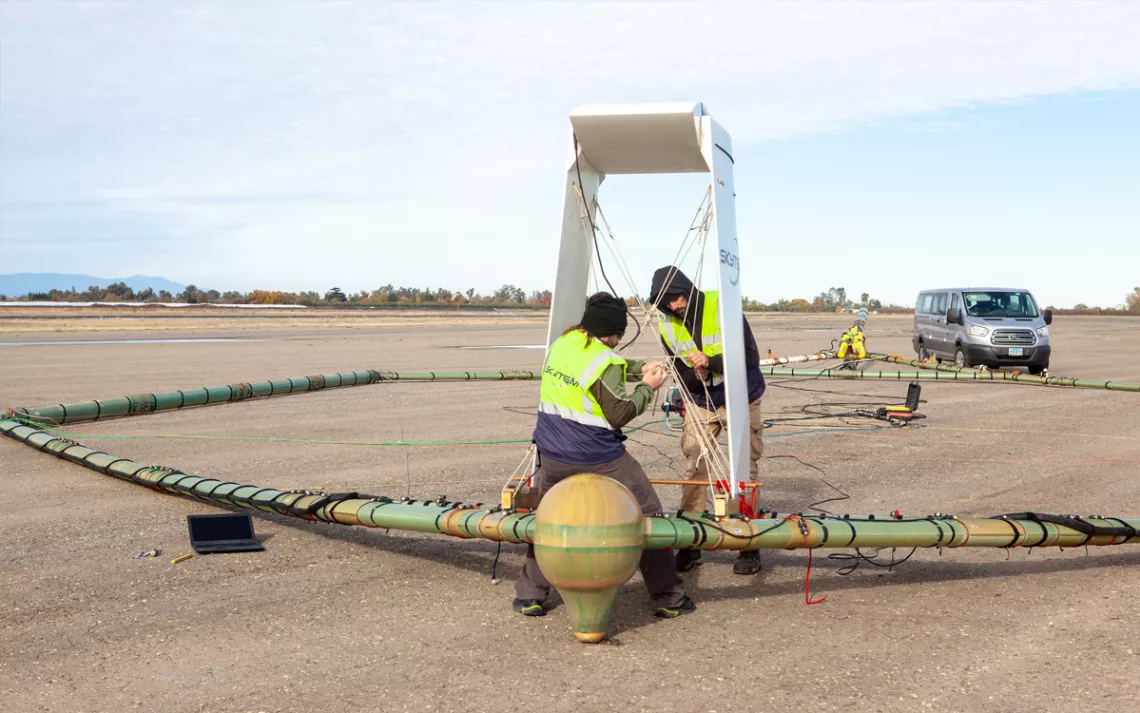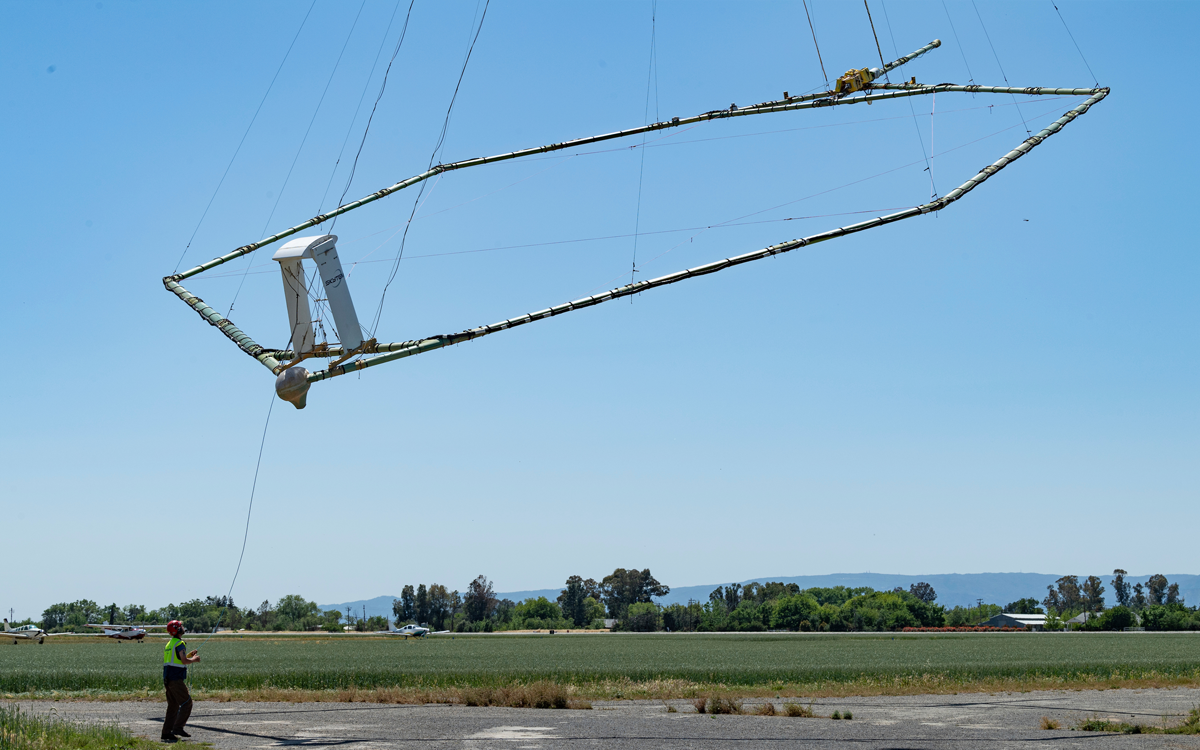Mapping a State's Secret Water
How groundwater mapping could be a game-changer for California

Skytem workers set up surveying equipment at Haigh Field in Orland, California. | Photo courtesy of Florence Low/California Department of Water Resources
In the first 11 days of 2017, California’s six-year-long drought ended in deluge. During that time, the state saw a quarter of its average annual rainfall. Record snowfall shut down ski resorts. In San Jose, people evacuated their houses in boats. The state’s reservoirs couldn’t contain it; the water gushed through spillways and toward the Pacific Ocean.
But the relief was temporary. The next year, California quickly sank back into drought.
This tale of extremes is California’s new normal, says Graham Fogg, a hydrogeologist at the University of California, Davis. To survive this climate-changed future, the state needs to capture those torrents—and the tools to do so are right beneath our feet. In California, hidden under the ground are aquifers that have the capacity to store an estimated 1.3 billion acre-feet of water—26 times all of the state’s reservoirs combined. All California needs to do is guide the floods caused by torrential rainfall into the ground, instead of out to sea. “If we just capture the upper 5 to 10 percent of flood flows, that is enough water to compensate for the loss of water due to climate change,” says Fogg.
Here’s the problem: We don’t know where to build this infrastructure. Because we can’t see groundwater, our understanding of it—where it is, which direction it flows, and how it connects to the surface—is limited. “It’s been out of sight, out of mind,” says Fogg.
That’s beginning to change. In 2021, California’s Department of Water Resources began an ambitious collaboration with a team of scientists to map the state’s complex groundwater network. The project will provide the data that local municipalities can use to begin harnessing the floods when they come.
On a late-spring day, a helicopter dragged a huge metal hoop high over Redding, California. It was the last stop in a year-long series of flights across rural California—from Ventura to Siskiyou County. The hoop, which generates an electric current, sent electromagnetic waves into the earth below, generating a kind of electromagnetic call-and-response. When hit by those waves, the material under the ground’s surface responds by creating its own unique electric current and corresponding electromagnetic wave. That response, which a device inside the helicopter receives and records, tells a story about the material that generated it: “Just like you’d get a snapshot of your body with an MRI,” says Ian Gottschalk, a hydro-geophysicist at civil-engineering firm Ramboll. Freshwater generates a signal different from saltwater, he says, and clay generates a signal different from gravel.

A helicopter demonstrates how an AEM subterranean survey is conducted. | Photo courtesy of Andrew Innerarity /California Department of Water Resources
The composition of the ground beneath our feet affects how much water the subsurface holds and how readily water percolates down through the sediment. Groundwater aquifers aren’t giant cavities under the ground. They’re more like sponges, made up of a coarse mixture of materials, such as silt, gravel, clay, and sand. Water rushes through the gaps between gravel and leaks slowly through clay. How quickly water moves through these materials varies by a factor of a million, says Fogg: “Anywhere from meters per day to centimeters per year.” By telling us about the composition of the earth, data from these surveys, called aerial electromagnetic surveys, or AEM, also tell us where we can “recharge” the aquifers most quickly during a rainstorm.
California has already invested millions in groundwater recharge, and projects are already underway across the state. On the Orange County coastline, heavy machinery injects water straight into the ground. Throughout Los Angeles County, engineered wetlands called “spreading-basins” percolate water down into the water table. But a strategy called Flood-MAR is what Don Cameron, a farmer who cultivates 5,500 acres near Fresno, is most excited about.
Cameron first noticed the water table under his land dropping more than three decades ago. His well motors strained harder and harder to pump the same amount of water. So in 2011, Cameron came up with what was then a brand-new idea: He would flood his wine grapes. To do so, Cameron installed a network of pumps and canals that push water up from the Kings River, which abuts his land, onto his fields. Raised banks called berms hold the water in place. “At one time, this was all a flood plain,” Cameron says. “We’re essentially reconnecting it.”
When Cameron first applied for a grant to test the idea, researchers he consulted warned that a flooded vineyard would kill the plants. But as Cameron saw it, his grapes would drink up some of the water; the floods would keep the weeds down and reduce the need for herbicides; and some of that water would trickle into the aquifers below. Win-win-win.
The plan worked. That August, Cameron picked a crop of perfect wine grapes, and the water table had risen 40 feet.
These days, Cameron is known as the “father of flood-MAR.” (To which Cameron says, “I’m too old; you can call me the grandfather.”) The practice, which specifically refers to flooding agricultural fields, is well known throughout the agricultural community in California and is slowly gaining recognition in other states that rely heavily on groundwater, such as Texas. Under California’s 2014 Sustainable Groundwater Management Act (SGMA), local coalitions of stakeholders, called Groundwater Sustainability Associations (GSAs) were required to submit to the state step-by-step plans to make sure they don’t further deplete groundwater in their area. Most of those plans involved Flood-MAR, says Yan Tang, a professor of governance and public policy at the University of Southern California. But in developing their sustainability plans, GSAs didn’t consider the geology of their aquifers. “This is where the AEM survey comes in,” Tang says. “You need the information to come up with a sensible sustainability plan.”
Cameron got lucky, land-wise. His farm is separated from the aquifer beneath it by a relatively permeable layer of sand, silt, and gravel. If his vineyard sat above dense clay, the water used to flood it might just sit at the surface, evaporating in the hot sun or causing damage to his plants. Others are luckier still—Fogg is optimistic that the AEM surveys will uncover underground formations called paleovalleys: areas where the subsurface is characterized by unusually coarse material, ideal for groundwater recharge. “Finding a paleovalley is kind of like finding the artery for an intravenous injection,” Fogg says.
Experts haven’t begun analyzing or implementing AEM data yet. Once they have, says Ajay Goyal, an engineer at the California Department of Water Resources, data from these surveys might help GSAs identify land ideal for recharge and zone it accordingly. Land that otherwise might be mined for gravel might instead be preserved as an access point for aquifers below. State agencies might also use the data to identify farmers who grow crops on suitable recharge areas, says Kamyar Guivetchi, also a civil engineer at the California Department of Water Resources, and pay them to implement flood-MAR.
Flood-MAR, and groundwater recharge in general, is popular among farmers—so popular that Guivetchi and Fogg anticipate the eventual construction of additional infrastructure to pipe excess floodwaters from the wetter, northern parts of California into the arid southern parts of the state. “Farmers recognize that over the next few decades, some farms may not be able to cultivate as much as they do now because of low groundwater supply,” Guivetchi says.
But first, the data. You can’t manage what you can’t see, says Gottschalk. “Otherwise, we’re more or less taking shots in the dark.”
 The Magazine of The Sierra Club
The Magazine of The Sierra Club



